This month BNSF placed in service 5 miles of fourth main track on the Hereford Subdivision through Amarillo, Texas.
Next month BNSF expects to open nearly 10 miles of new triple track on the Gallup Subdivision between Belen and Dalies, N.M.
And early next year along the Arizona-California border, BNSF will open a new section of triple track on its Needles Sub between West Needles and Ibis along with a 4-mile section of quadruple track on its Seligman Sub through the city of Needles, Calif.
The projects will position BNSF for further growth while improving velocity and fluidity for current traffic, Tom Williams, the railroad’s vice president for consumer products, told the North East Association of Rail Shippers fall conference on Wednesday.
The additional high iron will allow 70-mph intermodal trains to leap ahead of slower-moving merchandise and unit trains at crew-change points, Williams says, which will alleviate congestion and improve service.
BNSF’s average train velocity has dipped since late last year amid strong traffic growth and all-time volume records.
The project at Belen, where BNSF inspects and fuels trains, is particularly important.
“You want to have the ability for the faster trains to get around the slower-speed trains and get out in front of them on the network,” Williams says. “In terms of improving velocity this is going to be an impactful investment. It will come online in October.”
The Belen project work alone includes the installation of four new grade crossings, 17 switches, 27,000 concrete rail ties, and 100,000 feet of rail.
The projects are part of BNSF’s overall expansion and efficiency budget of $500 million this year.





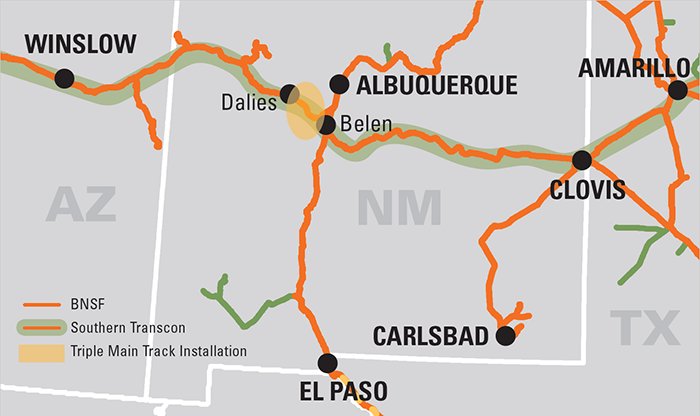
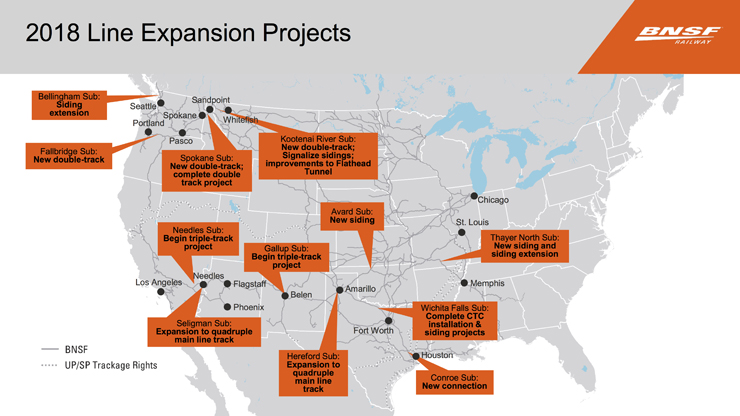

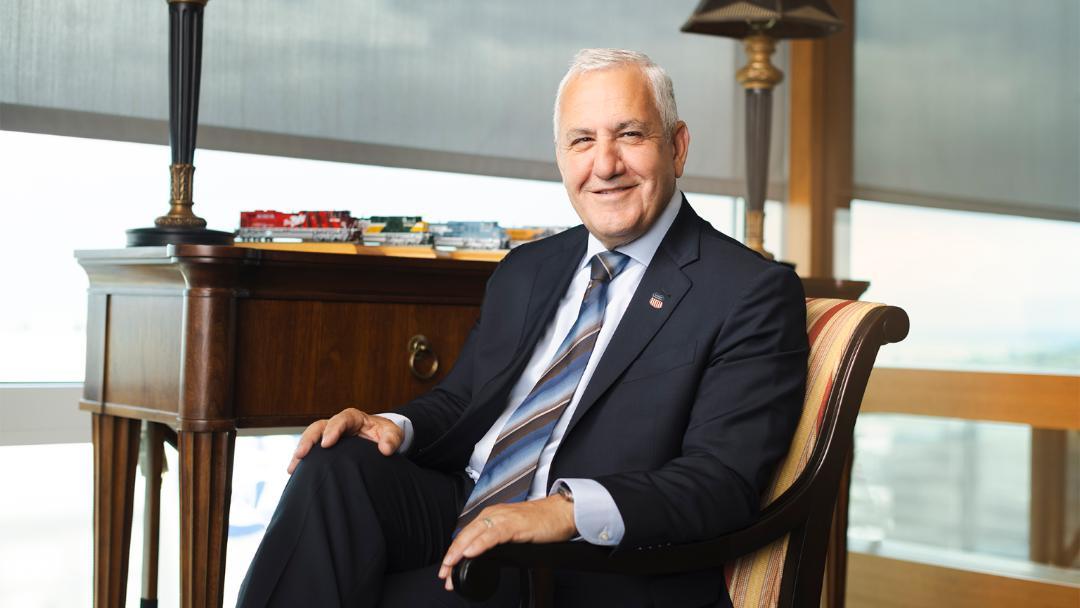
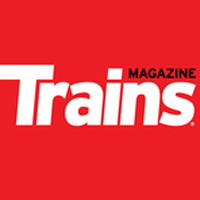
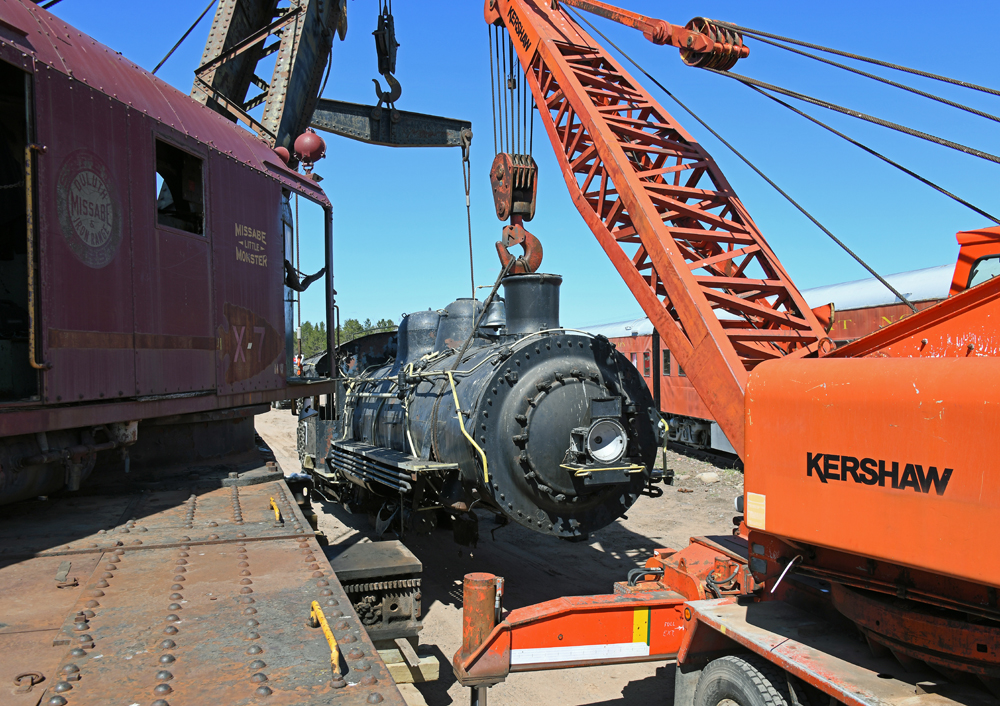
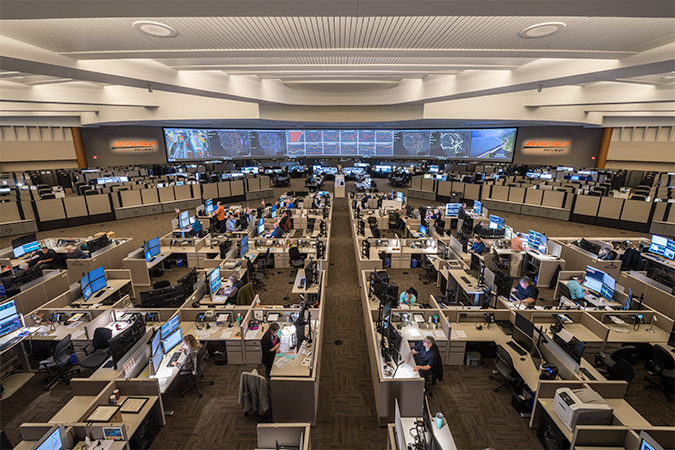




Mr Roberts – what (for where) is the CP MacDonald line.
In General I agree with the ‘no future for freight’ comments concerning Raton Pass EXCEPT, if manifest and/or intermodal trains could be balanced and scheduled for Front Range – S. Cal service or Front Range – Mexico service. A necessary condition would be that overhead costs now borne by the passenger operations were not shifted back to BNSF. Even if the balance and scheduling good be achieved, reestablishing the train handling experience required to work the grades would be a significant obstacle. Once York Canyon was gone, the line became an option, not a necessity. Unit trains are not an option due to siding length and the difficulty of balancing the crews. With other traffic, any overflow can be routed via Amarillo so that train lengths are maintained.
Glad I had the chance to ride a York Canyon turn, never thought I would outlive the line.
I don’t know about problems at Belen and Barstow, but having adequate Mountain power available at Argentine was a problem as early as the 70’s; traffic balance was part of the problem, maintenance was another as these classes were orphans. One day all 6 units in one class were in the low bay at Argentine at the same time………
Didn’t the Santa Fe, in the Rob Krebs, Pre-BNSF era, have a grain train run-away and crash on the Raton Pass line in which the engineer was killed?
The only value of Raton is for passengers, and this is questionable for 2 trains per day. Because of the curves, it takes the Chief 5 hours and 53 minutes to travel 267 miles between Albuquerque and Trinidad. This is about a 3-1/2 hour drive.
Instead, Amtrak could institute a bus bridge between Albuquerque and Pueblo. The eastern portion of the Chief could terminate in Denver, restoring Kansas City-Denver service. The Heartland Flyer could then be extended to Newton with through cars to both Denver and Chicago. The bus bridge would save enough time to enable Amtrak to route passengers through Pueblo and still maintain reasonable hours of service to Flagstaff. The bus bridge would be during daylight hours so people will still book sleeping cars. For the slight inconvenience of a bus bridge, Amtrak would be entering several new markets connecting Denver, Oklahoma City, Ft. Worth, Kansas City, and Chicago. The increase in train miles will be minimal and the money saved by not maintaining the Raton line would probably cover the cost. The capital to upgrade the Raton line could be used to rebuild the Superliners needed to launch the new services.
I would make an exception if Colorado and New Mexico were willing to maintain the line, but the only way this could be justified is if they were willing to operate a corridor with multiple frequencies between Denver and Albuquerque (perhaps to El Paso as well). I do think this is a route that could justify corridor service, but can it succeed on such a slow route? How much time could a Talgo train save? How much would have to be invested to make the Raton line competitive with I-25? Perhaps a bus bridge would work better for corridor service as well as Amtrak does with the San Joaquins.
Please don’t tell me people won’t ride a train with a bus bridge during daylight hours. The San Joaquins are doing fine. I support Amtrak’s long distance service but we need to spend the money in such a way as to maximize ridership and revenue, not to maintain 267 miles of mountain railroad for 2 trains per day. Yes, I would still ride the Chief, even with a bus bridge. I might also use KC-Ft. Worth or KC-Denver services as well.
Kip: Re: The Devils Lake line: No, GREAT for the taxpayer. The only taxpayer input was the portion of the railroad that needed to be raised as Devils Lake was becoming an inland sea. The pricetag was about $97 million, but only a small part of that was TIGER grant or the equivalent (don’t recall the exact funding mechanism). Amtrak was to put up a third, with BNSF the remainder. (Of course it could be argued that part of Amtrak’s portion was taxpayer money, but definitely not all.) BNSF not only paid for the rest, it added several hundred million more and completely rebuilt the railroad from Minot (Surrey) to Fargo via Grand Forks, laying ribbonrail and new ties, added sidings, and replaced an aging ABS system with CTC. Of course the line is PTC-equipped, too. So, not only did the taxpayers of Grand Forks, Devils Lake, and Rugby (and the area) retain their rail passenger service, BNSF freight service improved (and is less costly due to the creation of shorter routes) as BNSF operates the line now as an alternate main line to the route through New Rockford. Since the route has been upgraded, two new shuttle grain facilities were constructed along the route at Doyon and Lakota to serve area farmers whose grain trucks aren’t chewing up more local roads taking grain to more-distant facilities. And unlike highway projects everywhere (and Amtrak’s Raton Pass route to a certain extent), the taxpayer contribution to BNSF to complete this mammoth undertaking was a “one and done.” Build a new highway, and there’s the neverending costs of maintenance and traffic management. In other words, it’s pretty much impossible to imagine in this country where so much subsidy is given to the competitors of freight railroads that contributions to the freight railroads by the taxpayer wouldn’t be a good investment!
And, with regard to a discussion among operating managers with regard to Raton Pass, I cannot speak specifics, but yes, I doubt anyone misses it. My only experience there is as a power manager toward the last of the York Canyon coal trains (loaded at York Canyon mine near Raton, operated over Raton Pass and then via ex-BN to Midlothian, TX via Texline), and I can tell you it was a royal PITA gathering the amount of power necessary to get these small coal trains (by today’s standards) over that 3.5 percent hill. (The train actually went over in chunks…)
Mark: Superb response – never negative; most appreciated. My statement was simply stating the obvious. Like Tennessee Pass, the line may lay follow for decades. But in the long run, someone, like Bright Rail, could see the value of operating a high-speed rail link system between Denver & Albuquerque. As is being found in the Texas project (Houston-Dallas), obtaining land under non-public domain conditions certainly complicated their route. Allowing RP to stay in-place, even without AMTRAK, is what I believe BNSF will do.
Again, thanks for your expert/inside info on Devils Lake (good catch on my mental typo). It refreshing to read “There wasn’t a middle-manager (me included) working in that area of the railroad during the Bakken Boom that thought for a minute that the Devils Lake subdivision wasn’t needed, but we knew that in the end the politics behind the importance and fondness of/for the Empire Builder would result in funding being obtained eventually.”
Yup, BNSF played this one superbly with ac tax-payer subsidy to retain the route. My posit is “Why shouldn’t that concept be any different on the RP?” An imagined answer, my assumption meant without malice, would be “There wasn’t a middle-manager working in that area of the railroad that thought for a minute that the Raton Pass subdivision was needed.”
Thus you’ve sold me. It’s bad for the tax-payer, and BNSF see’s no need, to retain operation on Raton Pass for two trains a day. Thanks!
Mark, yes, I compared the timetable distances that the Super Chief (via the Main LIne) and the San Francisco Chief (via the Southern Transcon) traveled from Chicago to Gallup to come up with my figure. If Amtrak rerouted the Southwest Chief over the Southern Transcon (all the more appealing since BNSF is adding capacity to the line), wouldn’t the SW Chief follow the route of the old SF Chief?
Landon, you’re on to something. Amtrak could establish a hub at Wichita with the SW Chief connecting a Wichita-Denver train over the old Mainline and the Heartland Flyer extended to run from Wichita through OK City to Fort Worth.
Paul:
There’s no way the Raton Pass route will be ripped-out; rather I suspect (if AMTRAK bolts) that rails will lay fallow like Tennessee Pass and other routes that, while excess today, become valued as traffic surges. Besides, this is the only direct connection (north-south) from Belen. As we saw at Devil’s Lake, AMTRAK restored a route laid fallow by BNSF. A year later, we found more traffic from the Host then the Hosted.
Therefore your statement is spot-on; it’s a relief valve that is candidate for a spin-off to others, but a needed route for overhead BNSF traffic comes any capacity crunch, as MRL is for the Great Northern route in the Northwest.
The two question marks were meant to be a thumb up symbol
The Raton Pass route could relieve some of the traffic volume on the Southern Transcon. Merchandise freight trains and unit trains could especially be assigned through Raton Pass since they are slower and better suited to ascend grades with mid-train and/or rear-train power
Jeffrey Blackwood: You are incorrect. You are not able to determine the mileage difference (between the Raton Pass route and the Southern “Transcon”) by using your April 1971 Official Guide. The information is not available there because the mileage is not given between Mulvane and Ellinor (in Kansas) via El Dorado and Augusta; it’s given instead (for the San Francisco Chief) via Wichita and Newton. Though some BNSF trains are routed via Wichita today, the vast majority go via El Dorado, a route 28 miles SHORTER than the route through Wichita. This means the Southern “Transcon” is really that much shorter than via Raton Pass.
Kip William Grant: Your statement is completely incorrect. Braking it down: It will not “become valued” ever, ever again. No freight trains will operate this way again. BNSF has experienced surges since it has quit using the route, and has never looked back, even if the Southern “Transcon” is out of service (it detours via UP in preference). Instead, BNSF is taking the steps to ensure that there is adequate capacity, not only as indicated in this article, but also with its directional running on the ex-ATSF and ex-FW&D/C&S routes between Amarillo and Pueblo. And, overall, the amount of traffic on the Southern “Transcon” between Ellinor and Dalies is not greater than east of Ellinor or west of Dalies, so therefore the likelihood of needing such an alternate route is zero. (And of course, west of Dalies – where there is no alternate route – the profile of the railroad is much more challenging than the Southern “Transcon” between Ellinor and Dalies via Clovis which for the most part isn’t.) Your comparison of the Devils Lake route (it is not “Devil’s”) shows your ignorance of the relative operations. There wasn’t a middle-manager (me included) working in that area of the railroad during the Bakken Boom that thought for a minute that the Devils Lake subdivision wasn’t needed, but we knew that in the end the politics behind the importance and fondness of/for the Empire Builder would result in funding being obtained eventually. The Bakken situation – and the rise of the lake – hastened the raising of the track. And, unlike the Raton Pass route, there was never not any business on the Devils Lake subdivision. BNSF was spending millions per year routing traffic circuitously betting that they’d get help to do the project to raise the railroad, which did happen. There is traffic through Devils Lake because there is traffic that logically routes that way, contrary to Raton Pass whose profile negates any such thing. And that’s why you’re additionally wrong in stating the Raton Pass route could be a “spin-off.” What entity would want a railroad with zero traffic and zero traffic potential?
Paul E Vinson: Your statement about merchandise trains and unit trains operating via Raton Pass is ridiculous. Distributed power is hardly the panacea you claim for heavy trains, especially since these trains would need three to four TIMES the power to operate via Raton versus their current route via Boise City and Clovis. With a trailing tonnage limit of less than 4,000 tons over Raton, the 19,000-ton coal trains or 16,000-ton grain trains currently moving from Pueblo to Arizona/California via Boise City and Clovis would not only need exponentially more power via Raton, but it would need to be cut in three or four places midtrain. This means that not only would running trains over this route take many, many more expensive assets, but they would consume time and crew cost configuring the power on the train, and removing the midtrain power at destination or another location. The reality is that the mere suggestion of running such trains over the 3.5 percent grade of Raton has never actually been entertained by actual railroad operating personnel; you only see such things in forums like this…..
Braden Kaygenich: Right on. The path to operating efficiency includes investing in the most efficient route, not the least-efficient.
@ Paul Vinson
The main problems with Raton Pass are the steep grades (upwards of 3%), circa 1940’s signal circuitry, and a route that was not intended for trains beyond 5,000 foot lengths (especially with some parts being like the Durango & Silverton High Line).
Now, if BNSF did to Raton like what CP did in 1984 (The MacDonald Line), then Raton could very well be used again. But that would take several billion dollars to accomplish and BNSF does not spend monies for projects of that scale. (Oh, well. It would do a lot of long term good if they did that for Raton and themselves.)
BNSF sure is doing some impressive stuff with their southern transcon route, unfortunately for us romantics I think Branden is correct, because of crew logistics and the steepness of the grades Raton Pass will be out of service unless the Chief stays on it.
I sure am glad Warren Buffet bought the BNSF so they can spend their profits wisely to increase capacity for more efficient operations and future growth and profits instead of worrying about OR and wasting it on stock buy backs just to please short sighted investors. I sure hated having to sell my BNSF stock at the time, but think it will pay off in future appreciation of the Berkshire stock I got in return.
@Paul E Vinson
Ratin Pass has 3% grades…Raton Pass is irrelevant. It’s a stiff climb and expensive to operate, and lacks capacity, and the room to add capacity .. Why would BNSF invest in a in efficient route??? When they can increase capacity in the existing efficient southern transcon.
Paul, Before the double tracking of the Southern Transcon, the Raton Pass line was considered the second track of Santa Fe’s mainline. In later years, the RP line served as a ‘safety value” when the Southern Transcon was saturated with trains. The Raton Pass is 15 miles shorter according to the ATSF timetable in my April 1971 Official Guide. However, i suspect train velocity is much higher on the Transcom rather it would be on the RP line because it’s a better route in grades and speed.. .